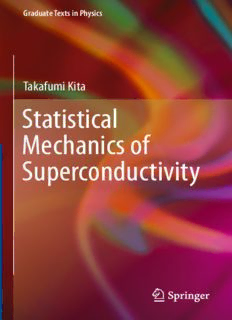Table Of ContentGraduate Texts in Physics
Takafumi Kita
Statistical
Mechanics of
Superconductivity
Graduate Texts in Physics
SeriesEditors
ProfessorRichardNeeds
CavendishLaboratory
JJThomsonAvenue
CambridgeCB30HE,UK
[email protected]
ProfessorWilliamT.Rhodes
DepartmentofComputerandElectricalEngineeringandComputerScience
ImagingScienceandTechnologyCenter
FloridaAtlanticUniversity
777GladesRoadSE,Room456
BocaRaton,FL33431,USA
[email protected]
ProfessorSusanScott
DepartmentofQuantumScience
AustralianNationalUniversity
ScienceRoad
Acton0200,Australia
[email protected]
ProfessorH.EugeneStanley
CenterforPolymerStudiesDepartmentofPhysics
BostonUniversity
590CommonwealthAvenue,Room204B
Boston,MA02215,USA
[email protected]
ProfessorMartinStutzmann
WalterSchottkyInstitut
TUMünchen
85748Garching,Germany
[email protected]
Graduate Texts in Physics publishes core learning/teachingmaterial for graduate-
andadvanced-levelundergraduatecoursesontopicsofcurrentandemergingfields
within physics, both pure and applied. These textbooks serve students at the
MS- or PhD-level and their instructors as comprehensive sources of principles,
definitions,derivations,experimentsandapplications(asrelevant)fortheirmastery
and teaching, respectively. International in scope and relevance, the textbooks
correspondtocoursesyllabisufficientlytoserveasrequiredreading.Theirdidactic
style, comprehensiveness and coverage of fundamental material also make them
suitable as introductions or references for scientists entering, or requiring timely
knowledgeof,aresearchfield.
Moreinformationaboutthisseriesathttp://www.springer.com/series/8431
Takafumi Kita
Statistical Mechanics
of Superconductivity
123
TakafumiKita
DepartmentofPhysics
HokkaidoUniversity
Sapporo,Japan
ISSN1868-4513 ISSN1868-4521 (electronic)
GraduateTextsinPhysics
ISBN978-4-431-55404-2 ISBN978-4-431-55405-9 (eBook)
DOI10.1007/978-4-431-55405-9
LibraryofCongressControlNumber:2015939274
SpringerTokyoHeidelbergNewYorkDordrechtLondon
Translation from the Japanese language edition: TOUKEIRIKIGAKU KARA RIKAI SURU
TYODENDOURIRON by Takafumi Kita, (cid:2)c Saiensusha Co., Ltd. 1-3-25, Sendagaya, Shibuyaku,
Tokyo1510051,Japan2013.AllRightsreserved
©SpringerJapan2015
Thisworkissubjecttocopyright.AllrightsarereservedbythePublisher,whetherthewholeorpartof
thematerialisconcerned,specificallytherightsoftranslation,reprinting,reuseofillustrations,recitation,
broadcasting,reproductiononmicrofilmsorinanyotherphysicalway,andtransmissionorinformation
storageandretrieval,electronicadaptation,computersoftware,orbysimilarordissimilarmethodology
nowknownorhereafterdeveloped.
Theuseofgeneraldescriptivenames,registerednames,trademarks,servicemarks,etc.inthispublication
doesnotimply,evenintheabsenceofaspecificstatement,thatsuchnamesareexemptfromtherelevant
protectivelawsandregulationsandthereforefreeforgeneraluse.
Thepublisher,theauthorsandtheeditorsaresafetoassumethattheadviceandinformationinthisbook
arebelievedtobetrueandaccurateatthedateofpublication.Neitherthepublishernortheauthorsor
theeditorsgiveawarranty,expressorimplied,withrespecttothematerialcontainedhereinorforany
errorsoromissionsthatmayhavebeenmade.
Printedonacid-freepaper
SpringerJapanKKispartofSpringerScience+BusinessMedia(www.springer.com)
Preface
The purpose of this book is to present the fundamentals of the theory of
superconductivityin a self-containedmanner by developingand illustrating every
required technique of advanced equilibrium statistical mechanics. It is addressed
to graduate and undergraduate students who have finished elementary courses of
thermodynamics and quantum mechanics. No further background knowledge is
requiredinreadingthroughallthechapters.
Superconductivity is one of the most spectacular phenomena in nature and
typical of broken symmetries. The Bardeen–Cooper–Schrieffer(BCS) theory that
hasclarifiedithashadatremendousimpactonthewholefieldofphysics,ranging
from condensed-matter physics itself to nuclear and particle physics. Hence, one
may expect that learning superconductivity enables one to reach and acquire
key concepts and techniques of modern theoretical physics. This book treats
this fascinating topic from the viewpoint of statistical mechanics to clarify both
mathematicalandlogicalstructuresofthetheoryastransparentlyaspossible.
Standardtextbooksonthetopicusuallybeginbydescribingbasicexperimental
results such as the Meissner effect, show subsequently that electron–phonon
interactionsmay establish virtualattractive forces between electrons, and proceed
to present the BCS theory for homogeneous systems. Descriptions of the phe-
nomenologicalLondonandGinzburg–Landautheoriesareofteninsertedpriortothe
microscopicBCStheory.Inthisway,onemayseethatthesetheoriescandescribe
experiments exceedingly well and also acquire basic skills to use them for one’s
ownpurposes.However,itmaynotbeentirelyclearinthisstandardapproachwhere
superfluidity(flowwithoutdissipation)originates,whatcausestheMeissnereffect
to expel the magnetic field from the bulk, or how phase coherence responsible
for superfluidity is established. There is also a high threshold in learning about
superconductivityforthosewhoarenotwellacquaintedwithelectromagnetismor
especiallywellversedintopicsinsolid-statephysics.
With these observations, this book adopts an alternative approach based on
statistical mechanics. Specifically, it starts from statistical mechanics of quantum
ideal gases, adding one by one every new element that is required in under-
standing superconductivitytogether with relevanttechniquesof modern statistical
v
vi Preface
mechanics.Thetheoryofsuperconductivityisdevelopedonthisbasisbytakingfull
advantageofthesecond-quantizationmethodsothatmacroscopiccondensationinto
atwo-particleboundstateismanifest.ThestartingpointistheBCSwavefunction
inrealspace,whichiscloselyconnectedwiththecoherentstateforlasersandBose–
Einsteincondensates.Adefiniteadvantageofthisapproachisthatphasecoherence
isquiteapparent.Thebasicformulationistherebyperformedinrealspacetoderive
the Bogoliubov–de Gennes equations so that inhomogeneous cases and arbitrary
pairingsymmetrycanbestudiedonanequalfooting.TheBCStheoryispresented
subsequentlyasanapplicationofittohomogeneouss-wavepairing.
Itwouldbringgreatpleasuretome,theauthor,ifthebookishelpfulforstudents
fullofcuriosityandpioneeringspirit.Finally,Iwouldliketoexpressmygratitude
to Professor Koh Wada for a critical and careful reading of the manuscript and
consequentusefulcomments.
Sapporo,Japan TakafumiKita
February2015
Contents
1 ReviewofThermodynamics............................................... 1
1.1 ThermodynamicsandHiking........................................ 1
1.2 EquationofState..................................................... 3
1.3 LawsofThermodynamics ........................................... 4
1.4 EquilibriumThermodynamics....................................... 5
1.4.1 BasicEquation.............................................. 6
1.4.2 EquilibriumConditions .................................... 6
1.4.3 LegendreTransformationandFreeEnergy ............... 7
1.4.4 ParticleNumberasaVariable.............................. 8
1.5 ThermodynamicConstructionofEntropyandInternal
Energy ................................................................ 10
Problems ..................................................................... 11
2 BasicsofEquilibriumStatisticalMechanics............................. 13
2.1 EntropyinStatisticalMechanics .................................... 13
2.2 DerivingEquilibriumDistributions ................................. 16
2.2.1 MicrocanonicalDistribution ............................... 17
2.2.2 CanonicalDistribution ..................................... 18
2.2.3 GrandCanonicalDistribution.............................. 21
Problems ..................................................................... 23
References.................................................................... 23
3 QuantumMechanicsofIdenticalParticles.............................. 25
3.1 Permutation........................................................... 25
3.2 PermutationSymmetryofIdenticalParticles....................... 26
3.3 EigenspaceofPermutation........................................... 29
3.4 Bra-KetsforMany-BodyWaveFunctions.......................... 31
3.5 OrthonormalityandCompletenessofBra-Kets..................... 32
3.6 MatrixElementsofOperators....................................... 33
3.7 SummaryofTwoEquivalentDescriptions.......................... 33
3.8 SecondQuantizationforIdealGases................................ 34
3.9 CoherentState........................................................ 39
vii
viii Contents
Problems ..................................................................... 41
References.................................................................... 41
4 StatisticalMechanicsofIdealGases...................................... 43
4.1 BoseandFermiDistributions........................................ 43
4.2 Single-ParticleDensityofStates .................................... 45
4.3 MonoatomicGasesinThreeDimensions........................... 46
4.3.1 Single-ParticleDensityofStates........................... 46
4.3.2 ConnectionBetweenInternalEnergyandPressure....... 47
4.3.3 IntroducingDimensionlessVariables...................... 48
4.3.4 TemperatureDependencesofThermodynamic
Quantities ................................................... 50
4.4 High-TemperatureExpansions ...................................... 51
4.5 FermionsatLowTemperatures...................................... 52
4.5.1 FermiEnergyandFermiWaveNumber................... 52
4.5.2 SommerfeldExpansion..................................... 53
4.5.3 ChemicalPotentialandHeatCapacity .................... 55
4.6 BosonsatLowTemperatures........................................ 56
4.6.1 CriticalTemperatureofCondensation..................... 56
4.6.2 ThermodynamicQuantitiesofT <T .................... 57
0
4.6.3 ChemicalPotentialandHeatCapacityforT&T ......... 57
0
4.7 Bose-EinsteinCondensationandDensityofStates................. 58
Problems ..................................................................... 59
References.................................................................... 60
5 DensityMatricesandTwo-ParticleCorrelations ....................... 61
5.1 DensityMatrices ..................................................... 61
5.2 Bloch–DeDominicisTheorem...................................... 62
5.3 Two-ParticleCorrelationsofMonoatomicIdealGases ............ 67
Problems ..................................................................... 71
References.................................................................... 71
6 Hartree–FockEquationsandLandau’sFermi-LiquidTheory........ 73
6.1 VariationalPrincipleinStatisticalMechanics ...................... 73
6.2 Hartree–FockEquations ............................................. 74
6.2.1 DerivationBasedontheVariationalPrinciple ............ 74
6.2.2 DerivationBasedonWickDecomposition................ 77
6.2.3 HomogeneousCases........................................ 78
6.3 ApplicationtoLow-TemperatureFermions......................... 80
6.3.1 FermiWaveNumberandFermiEnergy................... 80
6.3.2 EffectiveMass,DensityofStates,andHeatCapacity.... 80
6.3.3 EffectiveMassandLandauParameter..................... 82
6.3.4 SpinSusceptibility.......................................... 84
6.3.5 Compressibility............................................. 86
6.3.6 LandauParameters ......................................... 87
Contents ix
Problems ..................................................................... 89
References.................................................................... 89
7 AttractiveInteractionandBoundStates................................. 91
7.1 AttractivePotentialinTwoandThreeDimensions................. 91
7.1.1 BoundStateinThreeDimensions......................... 92
7.1.2 BoundStateinTwoDimensions........................... 93
7.2 ConsiderationinWaveVectorDomain.............................. 94
7.3 Cooper’sProblem .................................................... 97
Problems ..................................................................... 98
References.................................................................... 99
8 Mean-FieldEquationsofSuperconductivity ............................ 101
8.1 BCSWaveFunctionforCooper-PairCondensation................ 101
8.2 QuasiparticleFieldforExcitations.................................. 103
8.3 Bogoliubov–deGennesEquations................................... 105
8.3.1 DerivationBasedonVariationalPrinciple ................ 106
8.3.2 DerivationBasedonWickDecomposition................ 113
8.3.3 MatrixRepresentationofSpinVariables.................. 115
8.3.4 BdGEquationsforHomogeneousCases.................. 117
8.4 ExpansionofPairingInteraction .................................... 119
8.4.1 IsotropicCases.............................................. 119
8.4.2 AnisotropicCases .......................................... 120
Problems ..................................................................... 122
References.................................................................... 122
9 BCSTheory ................................................................. 125
9.1 Self-ConsistencyEquations.......................................... 125
9.2 EffectivePairingInteraction......................................... 128
9.3 GapEquationandItsSolution....................................... 132
9.4 ThermodynamicProperties.......................................... 135
9.4.1 HeatCapacity............................................... 135
9.4.2 ChemicalPotential ......................................... 138
9.4.3 FreeEnergy................................................. 138
9.5 LandauTheoryofSecond-OrderPhaseTransition................. 139
Problems ..................................................................... 141
References.................................................................... 141
10 Superfluidity,MeissnerEffect,andFluxQuantization ................ 143
10.1 SuperfluidDensityandSpinSusceptibility......................... 143
10.1.1 SpinSusceptibility.......................................... 146
10.1.2 SuperfluidDensity.......................................... 147
10.1.3 Leggett’sTheoryofSuperfluidFermiLiquids............ 149
10.2 MeissnerEffectandFluxQuantization ............................. 151
10.2.1 Ampère’sLaw .............................................. 152
10.2.2 LondonEquation ........................................... 153
Description:This book provides a theoretical, step-by-step comprehensive explanation of superconductivity for undergraduate and graduate students who have completed elementary courses on thermodynamics and quantum mechanics. To this end, it adopts the unique approach of starting with the statistical mechanics o

